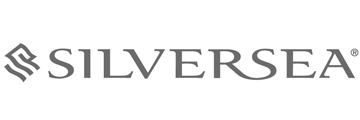This site uses cookies as defined in our Cookie Policy, by continuing to use this site you agree to their use.
Continue
Answer the call of the remote wonders of the Pacific and seek out Easter Island’s legends. This 24-day epic heads west from Chile, seeking out islands of mystique and encountering the iconic stone heads. Enjoy sublime beauty and visit castaway islands - like Pitcairn Island, of Bounty mutiny infamy. Accompany us onwards to the thrilling volcanic islands of the Marquesas, where natural sculptures, glowing waters and coral-ringed lagoons dazzle.
| Arrive | Depart | ||||||
| 31st31 | MarMar | 202525 | Valparaiso, Chile, embark on the Silver Cloud | 19:00 | |||
Valparaíso's dramatic topography—45 cerros, or hills, overlooking the ocean—requires the use of winding pathways and wooden ascensores (funiculars) to get up many of the grades. The slopes are covered by candy-color houses—there are almost no apartments in the city—most of which have exteriors of corrugated metal peeled from shipping containers decades ago. Valparaíso has served as Santiago's port for centuries. Before the Panama Canal opened, Valparaíso was the busiest port in South America. Harsh realities—changing trade routes, industrial decline—have diminished its importance, but it remains Chile's principal port. Most shops, banks, restaurants, bars, and other businesses cluster along the handful of streets called El Plan (the flat area) that are closest to the shoreline. Porteños (which means "the residents of the port") live in the surrounding hills in an undulating array of colorful abodes. At the top of any of the dozens of stairways, the paseos (promenades) have spectacular views; many are named after prominent Yugoslavian, Basque, and German immigrants. Neighborhoods are named for the hills they cover. With the jumble of power lines overhead and the hundreds of buses that slow down—but never completely stop—to pick up agile riders, it's hard to forget you're in a city. Still, walking is the best way to experience Valparaíso. Be careful where you step, though—locals aren't very conscientious about curbing their dogs. Since time immemorial Valparaiso has inspired writers, poets, musicians and artists alike. If the city is still a little rough around the edges, this only adds to its bohemian ambience; the architecture, style, street art, nightlife, and live music scenes of Valparaiso are some of the best in the world. Add colourful clifftop homes to the mix and you'll soon see why Valpariaso is many people's favourite Chilean city. The city was founded in 1536 by Spanish conquistador Juan de Saavedra, who named the city after his birthplace. Many of the colonial buildings he implemented are still standing today, despite the rain, wind, fire and several earthquakes (one of which almost levelled the city in 1906). Quirky architecture also abounds; poetry lovers and amateur architects will no doubt want to make the 45 km trip south to Chilean poet laureate (and Nobel Prize winner) Pablo Neruda’s ship-shaped house and museum for a taste of the extraordinary. The city and region are also extremely well known for their love of good food and wine. The vineyards of the nearby Casablanca Valley - first planted in the early 1980s - have earned worldwide recognition in a relatively short space of time. However, Chile’s viticulture history does date back much farther than that. De Saavedra brought grape vines on his voyage to South America in order to make his own wine and this led to a new grape brandy being created, Pisco. Today give any Chilean a Pisco and wherever they are in the world, they will be home. | |||||||
| 1st01 | AprApr | 202525 | At Sea | ||||
| 2nd02 | AprApr | 202525 | San Juan Bautista (Robinson Crusoe Island), Chile | 07:00 | 19:00 | ||
Robinson Crusoe Island is located 600 kilometres off the coast of Chile. The island is a rugged volcanic speck where 70 percent of its plant species are endemic, and is the largest of the Juan Fernandez Islands, a small archipelago that since 1935 is a Chilean National Park which was declared a UNESCO World Biosphere Reserve. This island has witnessed and played an important role in Chilean and world history. In 1750 the village of San Juan Bautista was founded at Cumberland Bay and by 1779 there were already 7 fortresses bristling with guns. The island’s isolation offered Spain a splendid place for setting up a penal colony, to which high-ranking Chilean patriots were deported in the early 19th century. In 1915, during the First World War, three British ships and a German one, the Dresden, engaged in a sea battle which ended with the scuttling of the German cruiser. Today there are currently around one thousand people living in the archipelago, most of them in the village of San Juan Bautista engaged in fishing for the “pincer-less lobster”, a delicacy in the mainland. Robinson Crusoe Island is located 600 kilometres off the coast of Chile. The island is a rugged volcanic speck where 70 percent of its plant species are endemic and is the largest of the Juan Fernandez Islands a small archipelago that since 1935 is a Chilean National Park which in 1977 was declared a UNESCO World Biosphere Reserve. This island has witnessed and played an important role in Chilean and world history. In 1704 the Scottish sailor Alexander Selkirk was marooned on the island and stayed for more than 4 years eventually inspiring Daniel Defoe’s novel Robinson Crusoe –hence the name of the island. 1750 the village of San Juan Bautista was founded at Cumberland Bay and by 1779 there were already 7 small fortresses bristling with guns. The island’s isolation offered Spain a splendid place for setting up a penal colony to which high-ranking Chilean patriots were deported in the early 19th century. In 1915 during the First World War three British ships and a German one the Dresden engaged in a sea battle which ended with the scuttling of the German cruiser. Today there are currently around one thousand people living in the archipelago most of them in the village of San Juan Bautista engaged in fishing for the “spiny lobster” a delicacy exported to the mainland. | |||||||
| 3rd03 | AprApr | 202525 | Alejandro Selkirk Island, Chile | 06:00 | 11:00 | ||
Alejandro Selkirk Island is part of the Juan Fernandez archipelago. The island itself was renamed in 1966 after the marooned sailor who served as the template for Daniel Defoe’s novel Robinson Crusoe, although Alejandro Selkirk was a castaway on a different island, named Robinson Crusoe Island. Alejandro Selkirk is located 165 kilometres west of the other islands in the archipelago. Throughout much of its history, the island has been uninhabited, although there is a former penal settlement on the middle of the east coast, which operated from 1909 to 1930. During the summer months, Selkirk welcomes a community of lobster fishermen and their families who come from Robinson Crusoe. As part of the Chilean National Park, it also holds the UNESCO World Biosphere Reserve title. The island is home to a number of rare and endangered plant and animal species. One of those iconic species—the Masafuera Rayadito—is found only on Selkirk; its global population numbers in the low hundreds and it is of particular interest to researchers and those looking to prevent species extinctions. Think of Daniel Defoe's classic novel Robinson Crusoe and you will be picturing an intrepid castaway, marooned on a paradisiacal island. That image might be ideal for movie lovers, but the actual inspiration for Robinson Crusoe was a salty Scottish seadog who went by the name of Alexander Selkirk. Selkirk was marooned in Chile's Juan Fernandez archipelago for four years and four months, rescued by a British private warship. Despite Selkirk's slightly chequered past, he was greeted as a celebrity upon his return to England. His adventures were given a gloss and immortalised in the much loved 18th century classic. Alejandro Selkirk Island is located 165 kilometres west of the other islands in the archipelago, for a surface area of just under 50 m2. The island was renamed from its Spanish name Isla Más Afuera in 1966 by the Chilean government in homage to the sailor. The topography is very different form the Caribbean dream that Defoe writes about, think dense woodland, rugged coast and peaks, shrouded (more often than not) in cloud. Sandy beaches can be found to the north of the island. Throughout much of its history, the island has been uninhabited, although there is a former penal settlement on the middle of the east coast, which operated from 1909 to 1930. During the summer months, Selkirk welcomes a small community of lobster fishermen and their families who come from Robinson Crusoe. As part of the Chilean National Park, it also holds the UNESCO World Biosphere Reserve title. | |||||||
| 4th04 | AprApr | 202525 | At Sea | ||||
| 5th05 | AprApr | 202525 | At Sea | ||||
| 6th06 | AprApr | 202525 | At Sea | ||||
| 7th07 | AprApr | 202525 | At Sea | ||||
| 8th08 | AprApr | 202525 | Hangaroa, Easter Island, Chile | 08:00 | |||
Discovered (by the Western world) on Easter Sunday, 1722, Easter Island is a UNESCO World Heritage Site and one of the most isolated places on the face of the Earth, some 2,300 miles from the Chilean mainland. Although more Polynesian than South American in character, the 64-square mile island was annexed by Chile in 1888, and is now famous as the world’s largest ‘open air museum’ on account of the Moai, or human-like stone statues, that can be found on the island. The Moai remain very much a mystery, which archaeologists are still trying to unlock by interpreting an ancient language of the Rapa Nui, which is the key to understanding this culture, and is written on the so called ‘rongo rongo tablets’. The island owes its origin to three volcanoes which erupted some three million years ago: Poike, Rano Kau and Maunga Terevaka. It is not known when or how the island was first populated, but the most credible theory suggests that the Rapa Nui people came from other Pacific islands in the 4th century AD. In addition to the cultural and archaeological interest, there are the beautiful beaches, transparent waters, and coral reefs that might be expected of a Pacific Island. Easter Island, the easternmost settled island of Polynesia, received its European name in 1722 when the island was seen by a Dutch expedition under Roggeveen on Easter Sunday. The triangular-shaped island of 163 square kilometers is famous for the hundreds of statues known locally as moai. Rolling hills covered in grassland, eucalyptus forest and a rocky shore surround Hangaroa, the island’s only village on the southwestern coast. This is where Captain Cook landed in 1774, where missionaries built the first church and where ships find the best protection from winds and swells. Small beaches and transparent waters invite swimmers and snorkelers, but it is the cultural aspect which attracts visitors. Since 1935 the island has been a National Historic Monument and today 43.5% of the island is a national park administered by the Chilean National Forest Corporation and Mau Henua, a local community group. The island’s national park has been declared a UNESCO World Heritage Site in 1995. Found slightly more than 3,500 kilometers west of Chile, the island was annexed in 1888. Used as a sheep ranch for many decades, the island was opened in 1965 and an airstrip was built. The US Air Force set up a base to record the behavior of the earth's outer atmosphere and by 1987 NASA had the runway extended as an emergency runway for the space shuttle. This never happened, but tourism benefitted from this improvement and today the island receives more than 100,000 visitors a year. | |||||||
| 9th09 | AprApr | 202525 | Hangaroa, Easter Island, Chile | 13:00 | |||
Discovered (by the Western world) on Easter Sunday, 1722, Easter Island is a UNESCO World Heritage Site and one of the most isolated places on the face of the Earth, some 2,300 miles from the Chilean mainland. Although more Polynesian than South American in character, the 64-square mile island was annexed by Chile in 1888, and is now famous as the world’s largest ‘open air museum’ on account of the Moai, or human-like stone statues, that can be found on the island. The Moai remain very much a mystery, which archaeologists are still trying to unlock by interpreting an ancient language of the Rapa Nui, which is the key to understanding this culture, and is written on the so called ‘rongo rongo tablets’. The island owes its origin to three volcanoes which erupted some three million years ago: Poike, Rano Kau and Maunga Terevaka. It is not known when or how the island was first populated, but the most credible theory suggests that the Rapa Nui people came from other Pacific islands in the 4th century AD. In addition to the cultural and archaeological interest, there are the beautiful beaches, transparent waters, and coral reefs that might be expected of a Pacific Island. Easter Island, the easternmost settled island of Polynesia, received its European name in 1722 when the island was seen by a Dutch expedition under Roggeveen on Easter Sunday. The triangular-shaped island of 163 square kilometers is famous for the hundreds of statues known locally as moai. Rolling hills covered in grassland, eucalyptus forest and a rocky shore surround Hangaroa, the island’s only village on the southwestern coast. This is where Captain Cook landed in 1774, where missionaries built the first church and where ships find the best protection from winds and swells. Small beaches and transparent waters invite swimmers and snorkelers, but it is the cultural aspect which attracts visitors. Since 1935 the island has been a National Historic Monument and today 43.5% of the island is a national park administered by the Chilean National Forest Corporation and Mau Henua, a local community group. The island’s national park has been declared a UNESCO World Heritage Site in 1995. Found slightly more than 3,500 kilometers west of Chile, the island was annexed in 1888. Used as a sheep ranch for many decades, the island was opened in 1965 and an airstrip was built. The US Air Force set up a base to record the behavior of the earth's outer atmosphere and by 1987 NASA had the runway extended as an emergency runway for the space shuttle. This never happened, but tourism benefitted from this improvement and today the island receives more than 100,000 visitors a year. | |||||||
| 10th10 | AprApr | 202525 | At Sea | ||||
| 11th11 | AprApr | 202525 | At Sea | ||||
| 12th12 | AprApr | 202525 | At Sea | ||||
| 13th13 | AprApr | 202525 | Pitcairn Island, Pitcairn | 08:00 | |||
With a total of 56 residents on the island, Adamstown is the capital of the Pitcairn Islands and the only populated settlement, as all of the other Pitcairn Islands are uninhabited (although were populated by Polynesians in the 11th through 15th centuries). Halfway between Peru and New Zealand, Pitcairn was the perfect hiding spot for the famed HMS Bounty mutineers and their Tahitian wives. Not only had the island been misplaced on early maps of the region, but it can also be very difficult to come ashore as large breakers tend to build up just in front of the small harbour of Bounty Bay. On shore visit the local museum that houses the HMS Bounty Bible, the historic Adamstown Church, view Fletcher Christian’s cave, or keep an eye out for the Pitcairn Reed Warbler. Home to the original mutineers of the Bounty, Adamstown’s is today the capital of all four Pitcairn Islands. The islands – the last British Overseas Territory in the Pacific – include the namesake Pitcairn Island itself, plus the uninhabited Oeno, Henderson and Ducie. Pitcairn is the archipelago’s only inhabited island, with the population of just 50 centred in Adamstown. It is no surprise that the nine mutineers along with six Tahitian men, 12 Tahitian women and one child stopped on Pitcairn in 1790; with its sloped and varied landscape, lush tropical promise and equidistant location between Peru and New Zealand, Pitcairn would have seemed an ideal hiding spot for the mutineers to settle. The ship was burnt to avoid detection (the ballast stone remains of the wreck in Bounty Bay). However, the ideal bucolic life that mutineer leader Fletcher Christian had envisaged was not to be. Poor treatment of the Tahitian men led to alcoholism, chaos and carnage and by 1800 only John Adams – who had recently discovered Christianity – remained. Adams taught the women and children to read and write from the bible. The capital is named after him. Not only had the island been misplaced on early maps of the region, but it can also be very difficult to come ashore as large breakers tend to build up just in front of the small harbour of Bounty Bay. The local museum houses the HMS Bounty Bible, the same bible that Adams taught the women and children to read and write from in the early 19th century. | |||||||
| 14th14 | AprApr | 202525 | Pitcairn Island, Pitcairn | 12:00 | |||
With a total of 56 residents on the island, Adamstown is the capital of the Pitcairn Islands and the only populated settlement, as all of the other Pitcairn Islands are uninhabited (although were populated by Polynesians in the 11th through 15th centuries). Halfway between Peru and New Zealand, Pitcairn was the perfect hiding spot for the famed HMS Bounty mutineers and their Tahitian wives. Not only had the island been misplaced on early maps of the region, but it can also be very difficult to come ashore as large breakers tend to build up just in front of the small harbour of Bounty Bay. On shore visit the local museum that houses the HMS Bounty Bible, the historic Adamstown Church, view Fletcher Christian’s cave, or keep an eye out for the Pitcairn Reed Warbler. Home to the original mutineers of the Bounty, Adamstown’s is today the capital of all four Pitcairn Islands. The islands – the last British Overseas Territory in the Pacific – include the namesake Pitcairn Island itself, plus the uninhabited Oeno, Henderson and Ducie. Pitcairn is the archipelago’s only inhabited island, with the population of just 50 centred in Adamstown. It is no surprise that the nine mutineers along with six Tahitian men, 12 Tahitian women and one child stopped on Pitcairn in 1790; with its sloped and varied landscape, lush tropical promise and equidistant location between Peru and New Zealand, Pitcairn would have seemed an ideal hiding spot for the mutineers to settle. The ship was burnt to avoid detection (the ballast stone remains of the wreck in Bounty Bay). However, the ideal bucolic life that mutineer leader Fletcher Christian had envisaged was not to be. Poor treatment of the Tahitian men led to alcoholism, chaos and carnage and by 1800 only John Adams – who had recently discovered Christianity – remained. Adams taught the women and children to read and write from the bible. The capital is named after him. Not only had the island been misplaced on early maps of the region, but it can also be very difficult to come ashore as large breakers tend to build up just in front of the small harbour of Bounty Bay. The local museum houses the HMS Bounty Bible, the same bible that Adams taught the women and children to read and write from in the early 19th century. | |||||||
| 15th15 | AprApr | 202525 | At Sea | ||||
| 16th16 | AprApr | 202525 | At Sea | ||||
| 17th17 | AprApr | 202525 | At Sea | ||||
| 18th18 | AprApr | 202525 | Hatiheu, French Polynesia | 08:30 | 18:30 | ||
| 19th19 | AprApr | 202525 | Atuona, Hiva Oa, French Polynesia | 06:30 | 12:30 | ||
| The largest of the southern islands Hiva Oa the master pillar or finial post of the ‘Great House’ - which represents the Marquesan archipelago in the local mythology - has always been the rival of Nuku Hiva. The island is shaped like a seahorse and has a mountain range running southwest to northeast whose main peaks Mt. Temetiu and Mt. Feani form a real wall around Atuona. Atuona a peaceful little port at the head of the Taaoa Bay also known as Traitors Bay has emerged from obscurity due to having had the privilege of being the last resting place of Paul Gauguin and of the singer Jacques Brel. The tombs of these famous personalities are on the side of the Calvary cemetery looking out across the bay and are places of great pilgrimage. In the village the Gauguin Museum displays items related to the painter's stay there at the beginning of the century and has copies of his works. | |||||||
| 19th19 | AprApr | 202525 | Tahuata Island, French Polynesia | 14:30 | 18:30 | ||
| 20th20 | AprApr | 202525 | Hana Vave, Fatu Hiva Island, French Polynesia | 06:30 | 13:30 | ||
| 21st21 | AprApr | 202525 | At Sea | ||||
| 22nd22 | AprApr | 202525 | Rangiroa, French Polynesia | 08:30 | 15:00 | ||
| Rangiroa is French Polynesia’s largest atoll. More than 400 motu (islets) enclose the lagoon, which is so wide and long that one cannot see the southern row of motu from the two main islets in the north –hence the local name Rangiroa meaning wide or long sky, sometimes taken as “immense sky”. There are several passes from the ocean into the lagoon and the two main villages of Avatoru and Tiputa are located next to the passes of the same names. Drift diving and snorkeling the incoming tides looking for sharks and manta rays at these passes is one of Rangiroa’s main touristic draws. Government jobs, ecotourism and pearl farming are the main sources of income on the atoll. The lagoon’s calm turquoise waters, rich marine underwater world and relaxed atmosphere attract visitors year-round to the many local guesthouses and a few hotels. Both Avatoru and Tiputa also feature schools for the other Tuamotu Islands which have no higher education possibilities. One of Rangiroa’s most unusual attractions is the white and rose wine produced on the islet immediately west of Avatoru –the wine has won several awards. | |||||||
| 23rd23 | AprApr | 202525 | Papeete, Tahiti, French Polynesia, disembark the Silver Cloud | 07:00 | |||
Papeete will be your gateway to the tropical paradise of French Polynesia, where islands fringed with gorgeous beaches and turquoise ocean await to soothe the soul. This spirited city is the capital of French Polynesia, and serves as a superb base for onward exploration of Tahiti – an island of breathtaking landscapes and oceanic vistas. Wonderful lagoons of crisp, clear water beg to be snorkelled, stunning black beaches and blowholes pay tribute to the island's volcanic heritage, and lush green mountains beckon you inland on adventures, as you explore extraordinary Tahiti. Visit to relax inside picturesque stilted huts, which stand out over shimmering water, as you settle into the intoxicating rhythm of life, in this Polynesian paradise. Papeete is the center of the tropical paradise of French Polynesia where islands fringed with gorgeous beaches and turquoise ocean await to soothe the soul. This spirited city is the capital of French Polynesia and serves as a superb base for onward exploration of Tahiti – an island of breathtaking landscapes and oceanic vistas. A wonderful lagoon of crisp clear water begs to be snorkelled stunning black beaches and blowholes pay tribute to the island's volcanic heritage and lush green mountains beckon you inland on adventures as you explore extraordinary Tahiti. Visit to relax and settle into the intoxicating rhythm of life in this Polynesian paradise. | |||||||
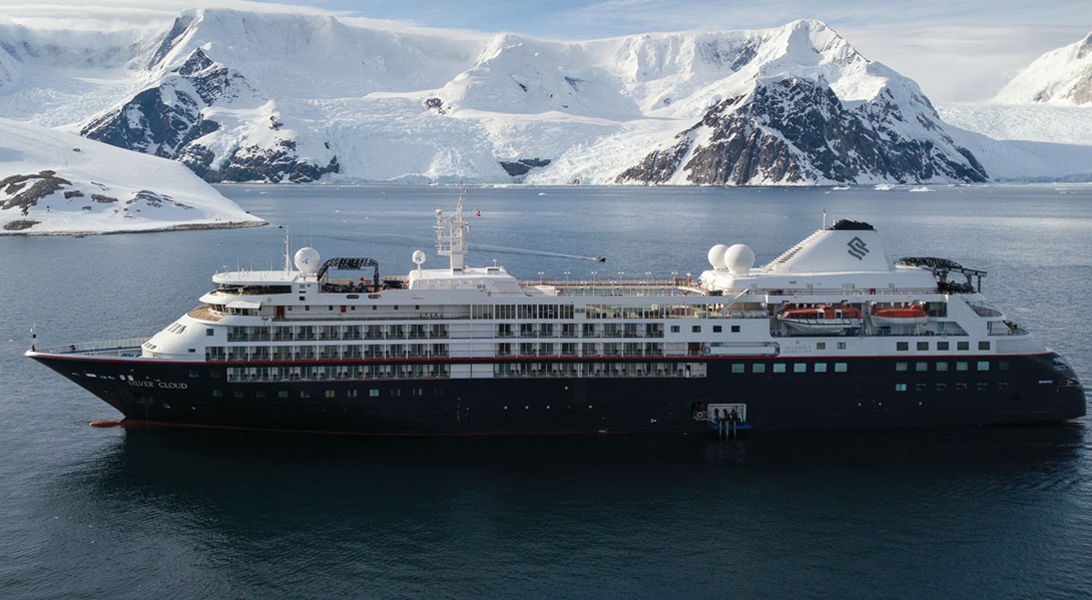







The images shown are for illustration purposes only and may not be an exact representation of what you find on the ship.
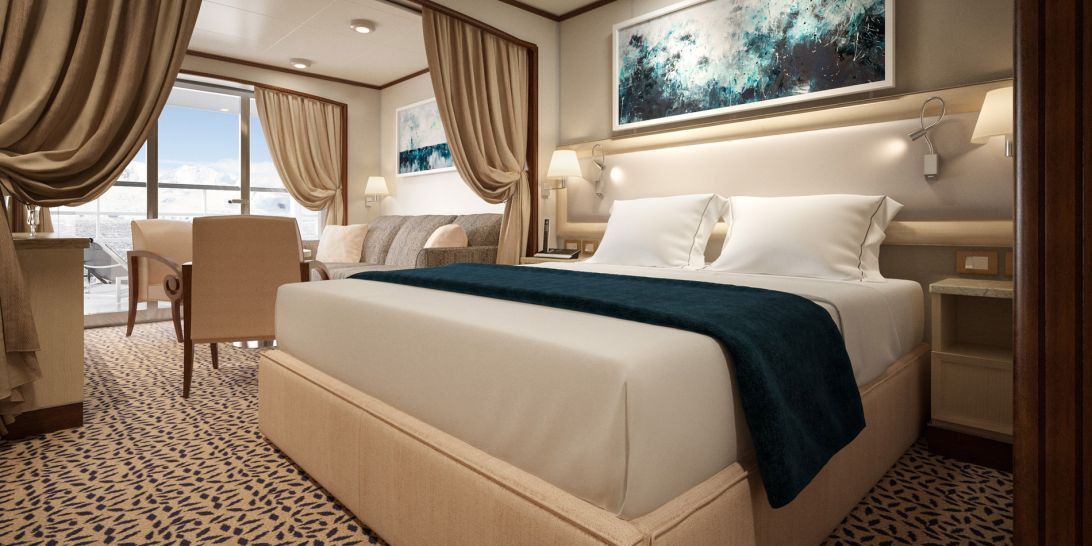
| Grade Code | From | To | |
| VR | Veranda Suite | £10,600 | £10,600 |
A Silversea signature, with a preferred central location, the Veranda Suite is spacious and welcoming.Floor-to-ceiling glass doors open onto a furnished private teak veranda from where you can contemplate anything from the midnight sun to an antarctic sunrise. The Deluxe Veranda Suite offers preferred central location with identical accommodation to a Veranda Suite.
One bedroom: 27 sq.m. including veranda
Two bedroom: 27 m² including veranda
Images are intended as a general reference. Features, materials, finishes and layout may be different than shown.
Essentials
Characteristics
Furniture
Media & Communication
Onboard Services
Amenities
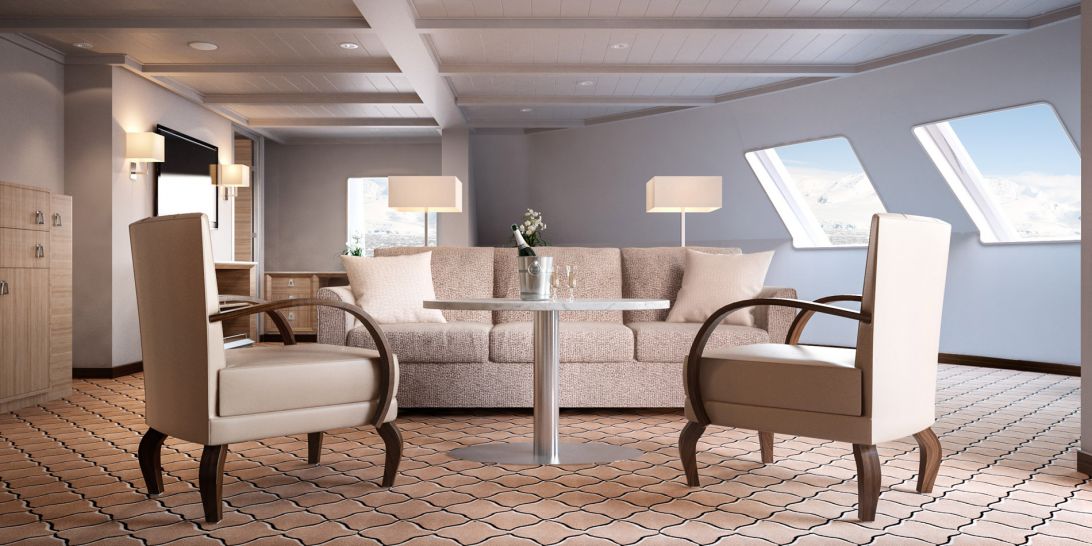
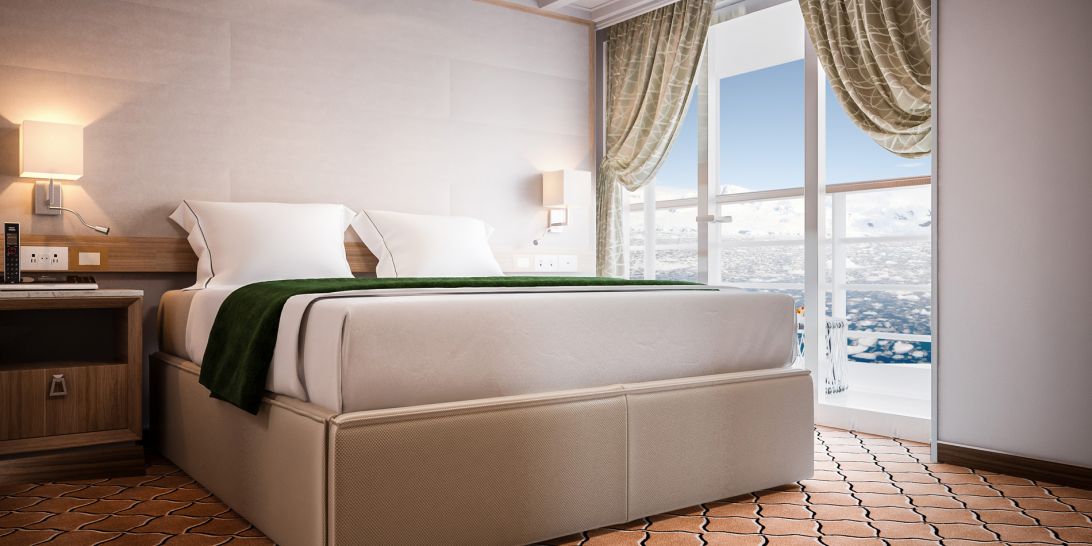
| Grade Code | From | To | |
| G1 | Grand Suite (1 Bedroom) | £37,900 | £37,900 |
| G2 | Grand Suite (2 Bedrooms) | £48,600 | £48,600 |
Expertly designed and exquisitely appointed. The ideal space for sharing stories with fellow explorers and new friends. With enough space to roam both in and outside, this suite is perfect relaxing and recounting the highlights of your day. Available as a one-bedroom configuration or as two-bedroom by adjoining with a Veranda Suite.
One bedroom: 95 sq.m. including veranda
Two bedroom: 122 sq.m. including veranda
Images are intended as a general reference. Features, materials, finishes and layout may be different than shown.
Please note that the 3rd guest will sleep on a comfortable sofa bed in the reception area of the suite.
Essentials
Characteristics
Furniture
Media & Communication
Onboard Services
Amenities
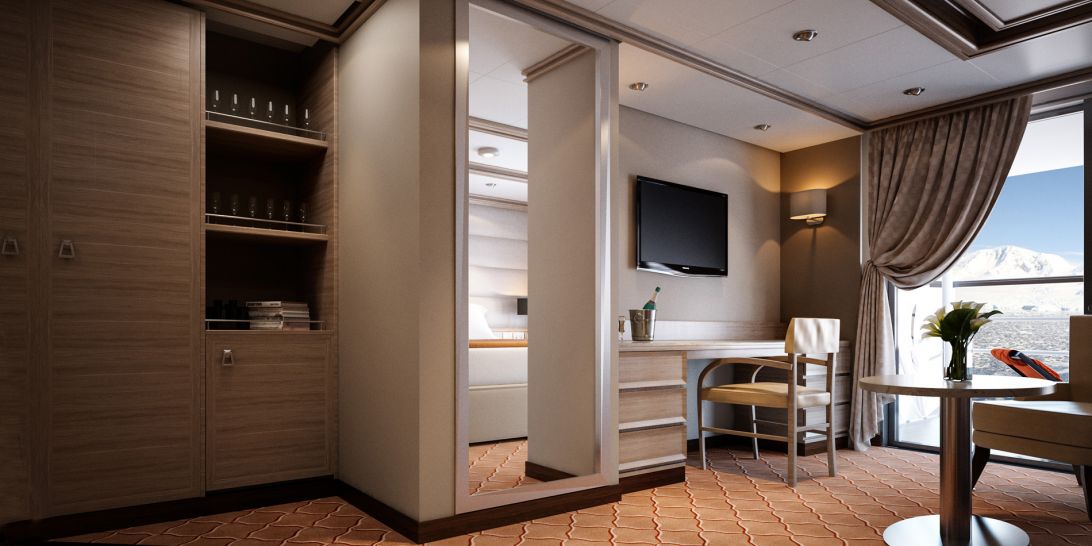
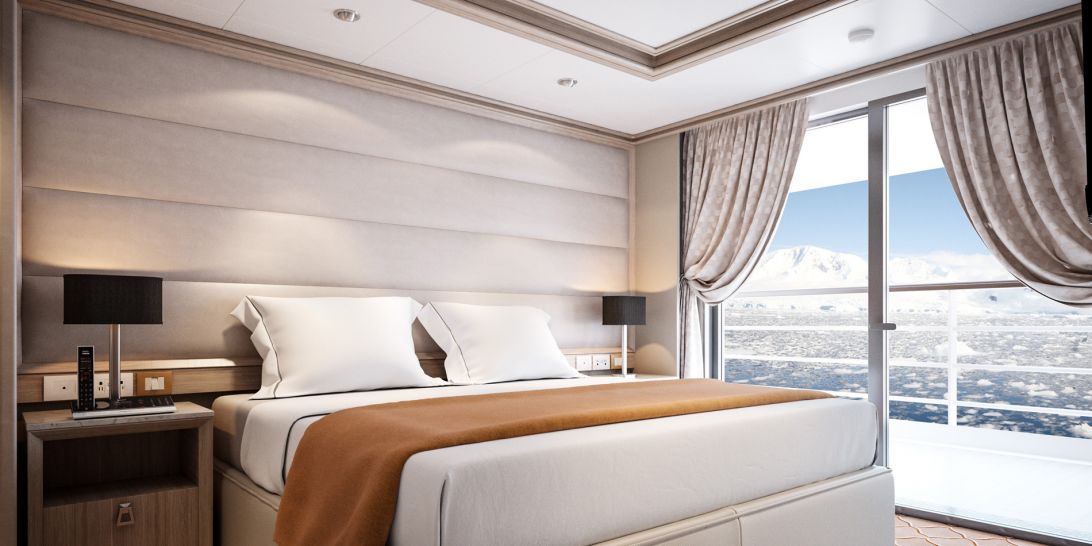
| Grade Code | From | To | |
| ME | Medallion Suite | £29,600 | £29,600 |
With a room configuration that favours watching the sun rise from the comfort of your bed and losing yourself in the mesmerising seascapes, this suite is the perfect answer to adventure cruising. A large walk-in wardrobe, and an expansive living make the Medallion Suite a your home away from home on the high seas. Medallion Suites accommodate three guests.
One bedroom: 48 sq.m. including veranda
Images are intended as a general reference. Features, materials, finishes and layout may be different than shown.
Please note that the 3rd guest will sleep on a comfortable sofa bed in the reception area of the suite.
Essentials
Characteristics
Furniture
Media & Communication
Onboard Services
Amenities
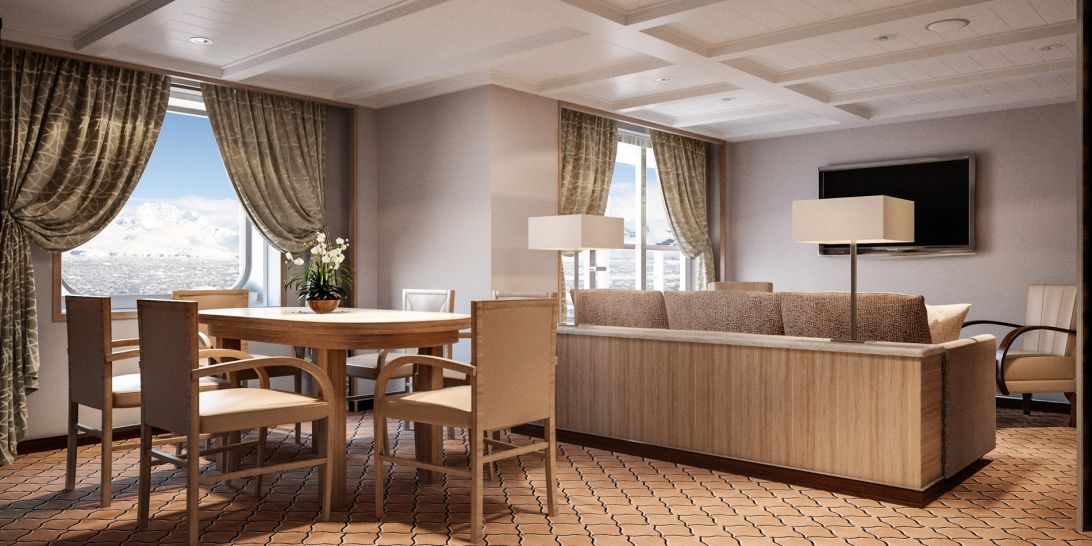
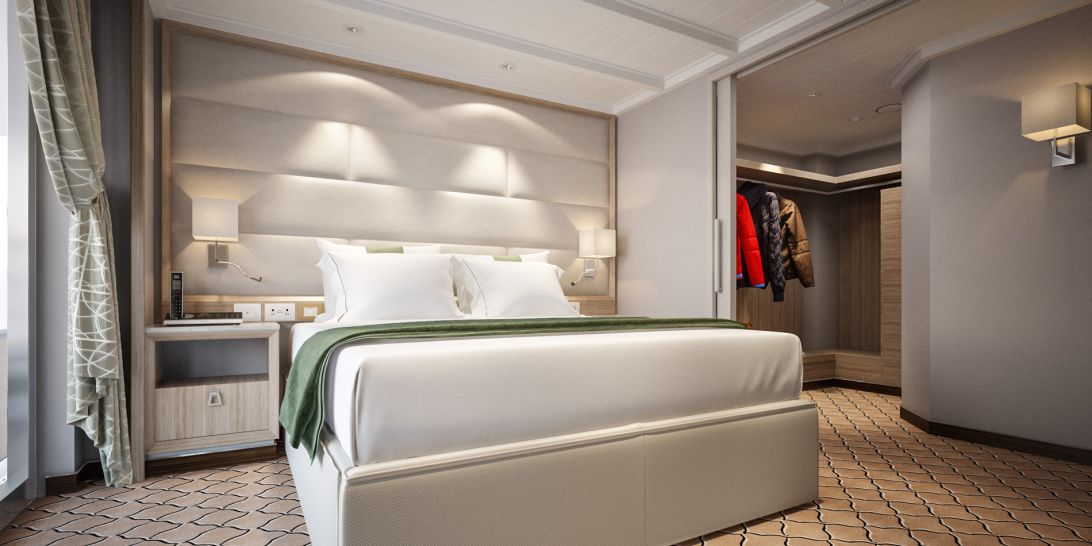
| Grade Code | From | To | |
| O1 | Owner's Suite (1 Bedroom) | £41,800 | £41,800 |
| O2 | Owner's Suite (2 Bedrooms) | £49,600 | £49,600 |
This stylish apartment offers the superlative in levels of space, comfort and service on board. A perfect mix of expedition experience with luxury lifestyle. Available as a one-bedroom configuration or as two bedroom by adjoining with a Vista Suite.
One bedroom: 55 sq.m. including veranda
Two bedroom: 77 sq.m. including veranda
Images are intended as a general reference. Features, materials, finishes and layout may be different than shown.
Please note that the 3rd guest will sleep on a comfortable sofa bed in the reception area of the suite.
Essentials
Characteristics
Furniture
Media & Communication
Onboard Services
Amenities
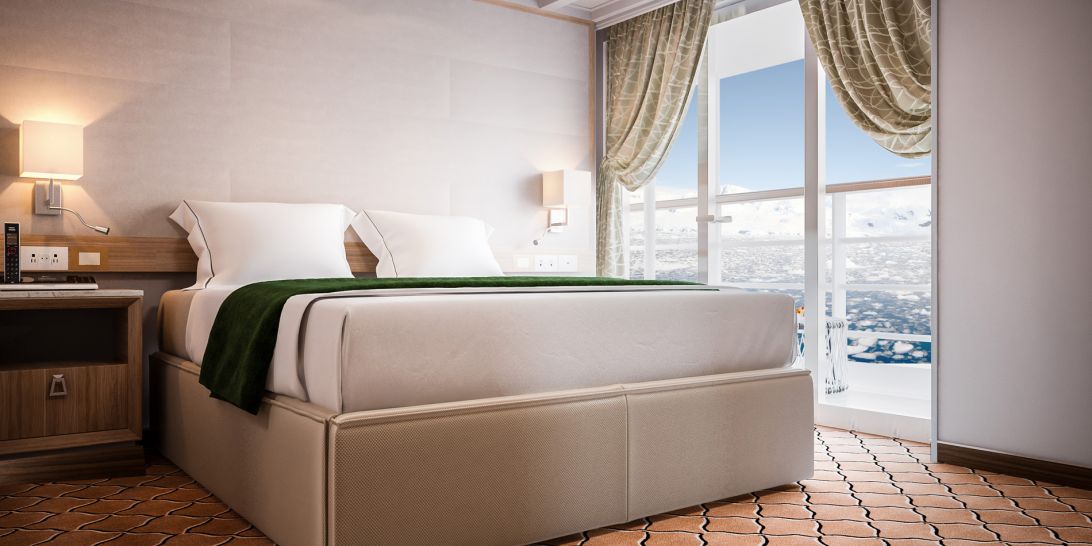
| Grade Code | From | To | |
| R1 | Royal Suite (1 Bedroom) | £34,300 | £34,300 |
| R2 | Royal Suite (2 Bedrooms) | £45,000 | £45,000 |
Stately. Commanding and majestic. Perfect for relaxing after a days’ exploring and looking through your photos. With lectures being streamed live to your room, this is the pinnacle of good living at sea. Available as a one-bedroom configuration or as two-bedroom by adjoining with a Veranda Suite.
One bedroom: 69 sq.m. including veranda
Two bedroom: 96 sq.m. including veranda
Images are intended as a general reference. Features, materials, finishes and layout may be different than shown.
Please note that the 3rd guest will sleep on a comfortable sofa bed in the reception area of the suite.
Essentials
Characteristics
Furniture
Media & Communication
Onboard Services
Amenities
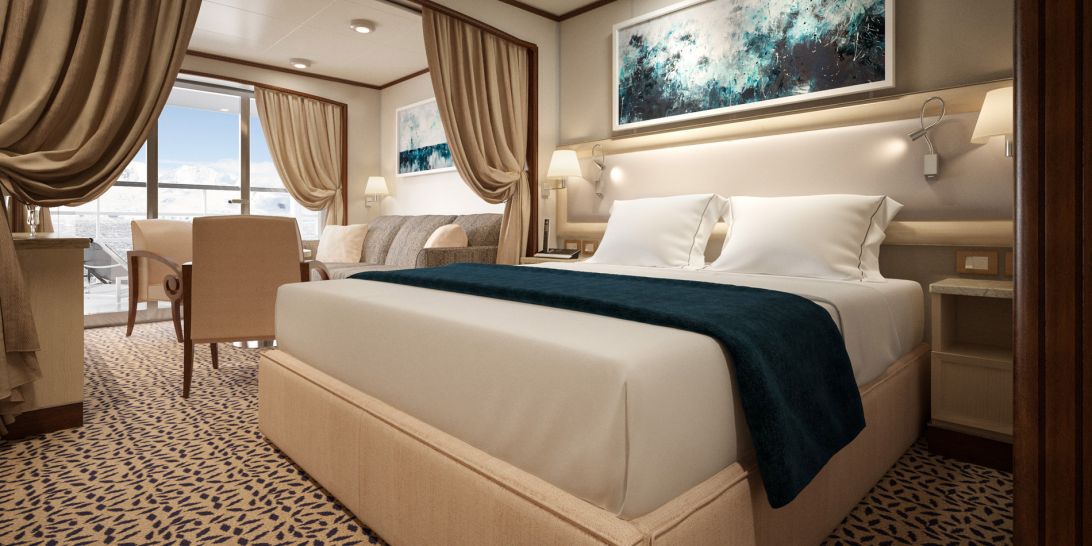
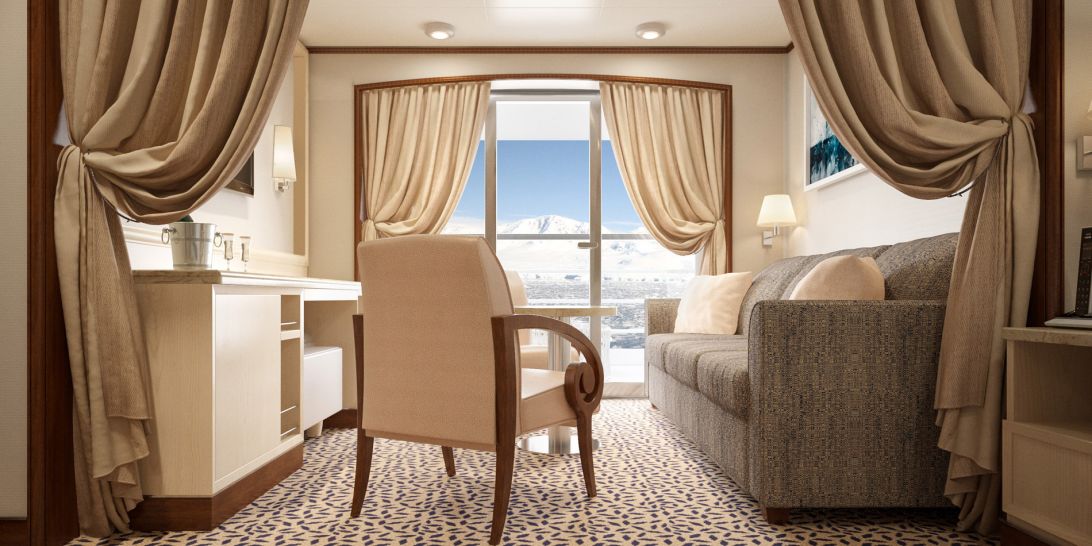
| Grade Code | From | To | |
| DV | Midship Veranda Suite | £13,900 | £13,900 |
A Silversea signature, the Veranda Suite is spacious and welcoming. Floor-to-ceiling glass doors open onto a furnished private teak veranda from where you can contemplate anything from the midnight sun to an antarctic sunrise. Some Veranda Suites accommodate three guests (Suites going from 505 to 510 and from 605 to 610).
One bedroom: 27 sq.m. including veranda
Images are intended as a general reference. Features, materials, finishes and layout may be different than shown.
Please note that the 3rd guest will sleep on a comfortable sofa bed in the reception area of the suite.
Essentials
Characteristics
Furniture
Media & Communication
Onboard Services
Amenities
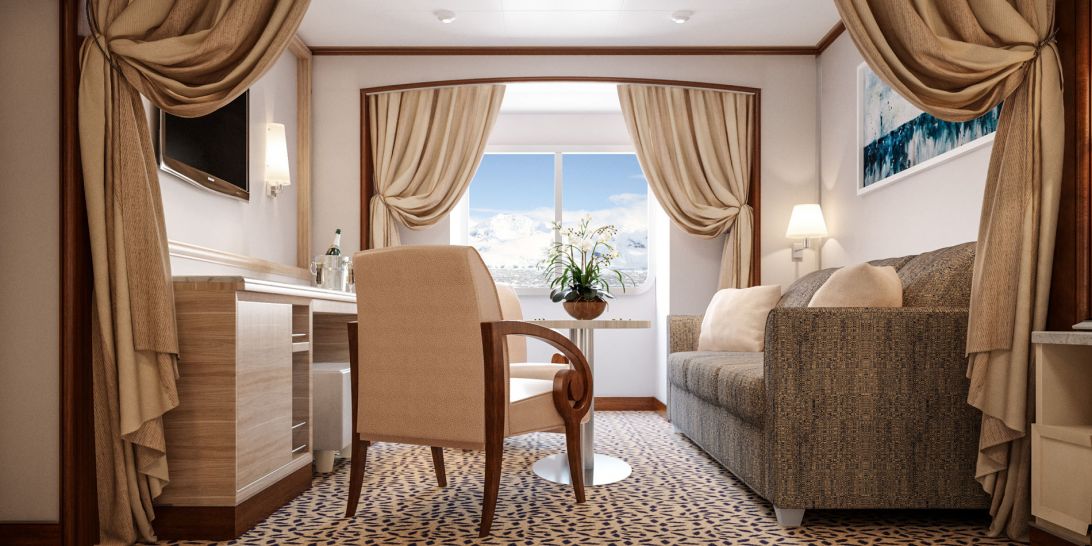
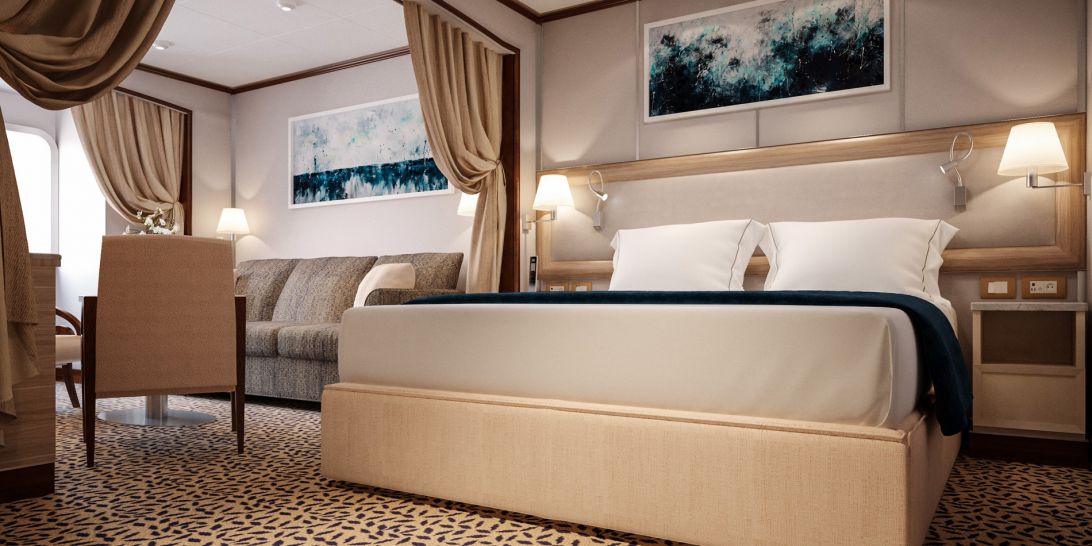
| Grade Code | From | To | |
| VI | Vista Suite | £7,400 | £7,400 |
Your home away from home while you embrace the intrepid explorer within. The suite’s seating area has plenty of room to relax while you go over your notes, ready for the next adventure. Large picture windows frame panoramic ocean views, ideal for appraising the local wildlife.
One bedroom: 22 sq.m.
Wheelchair accessible suites: 449 and 451
Images are intended as a general reference. Features, materials, finishes and layout may be different than shown.
Essentials
Characteristics
Furniture
Media & Communication
Onboard Services
Amenities
The images shown are for illustration purposes only and may not be an exact representation of what you find on the ship.
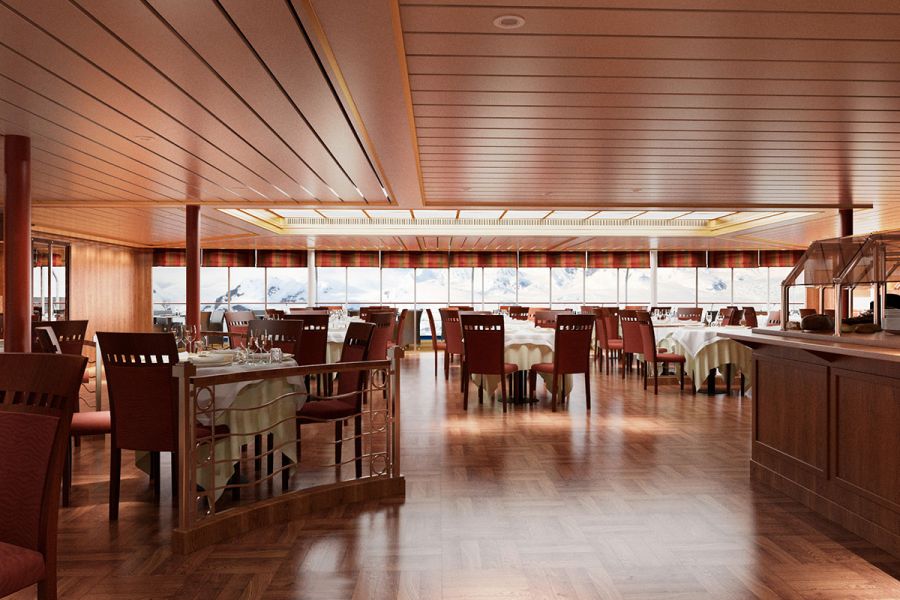
Authentic Italian recipes and the freshest, sustainable ingredients come together in this restaurant at sea.
Offering the very best of Italian cuisine, La Terrazza’s freshly made authentic a la carte dishes are complimented by a wide range of complimentary wines, even in the most remote of destinations! Using only the best seasonal produce, La Terrazza offers buffet restaurant for breakfast and lunch with indoor or al fresco seating and is transformed into an intimate Italian restaurant for dinner.
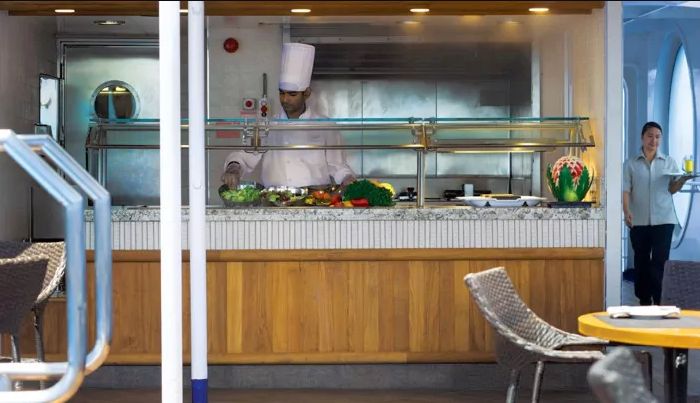
Soft breezes and ocean views beckon at the Grill, especially as the sun goes down when cruise guests gather for cocktails at the outdoor bar and talk about the day’s events.
One of the healthiest cuisines to exist, The Grill features lava stone cooking at its finest. Sourced from volcanic rock and placed in an oven to reach an optimum temperature of 400˚C, The Grill invites guests to cook their food directly at their table. Place your meat, fish or vegetables on top of the grill stone or inside the soup bowl, and then simply cook to your very own taste. Every bite is cooked to perfection, time after time. With the stone cooking available in the evenings only, The Grill becomes a daytime rotisserie and gourmet salad and burger bar, offering build your own burgers from the best selections of meat.
Dress code: Casual
Casual wear consists of pants, blouses or casual dresses for women; open-neck shirts and slacks for men are appropriate.
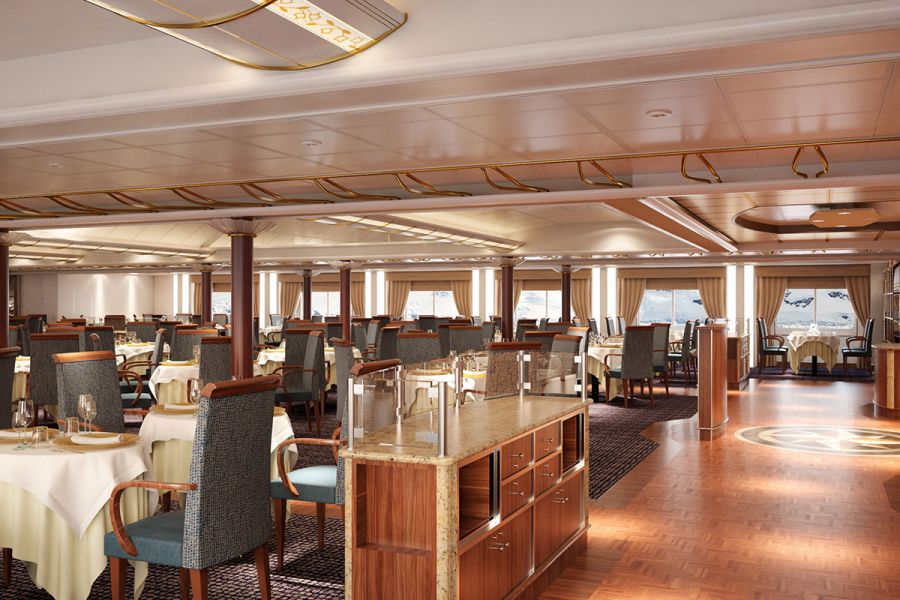
Enjoy Continental and regional specialities, as well as sweeping ocean views in our main dining room.
Sparkling with tales of adventure, bonhomie and like-minded friends, The Restaurant offers contemporary, international cuisine created by our most talented chefs. Menus feature regional specialities unique to the destinations guests visit on their cruise, so don’t be surprised to see a roasted Chilean Sea Bass while cruising the Chilean fjords.
The images shown are for illustration purposes only and may not be an exact representation of what you find on the ship.
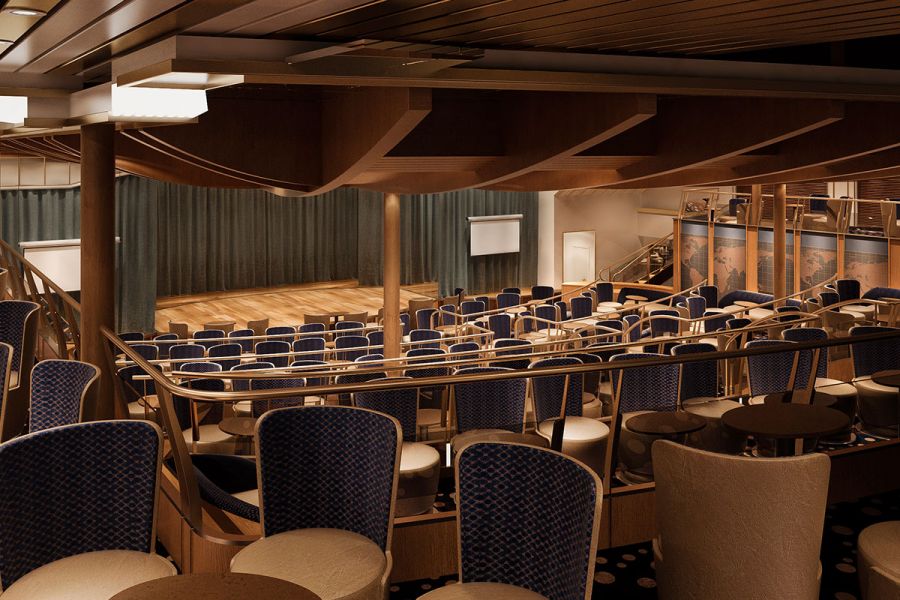
Perfect for presentations, lectures and video screenings, this is where our team of dedicated experts share their knowledge on their specialised subject, not to mention their infectious passion and energy. Multi-tiered Explorer Lounge and banquette style seating ensure that you enjoy every minute of the talk and with lectures being streamed live to your suite if desired, this is one of the very few lecture theatres at sea theatre to combine such comfort with such technology.

Relax and unwind in the Panorama Lounge, a sophisticated yet amicable space offering beautiful ocean views as you enjoy your cruise.
The Panorama Lounge is specially designed to provide an uninterrupted view of the day’s destination from the comfort of the luxury cruise ship’s interior. This is an ideal place to unwind on your cruise, enjoy afternoon tea, listen to the pianist and watch the setting sun. The drinks are complimentary, the music live and inviting. Enjoy dancing to a range of musical styles for every taste from standards to the latest club mixes.
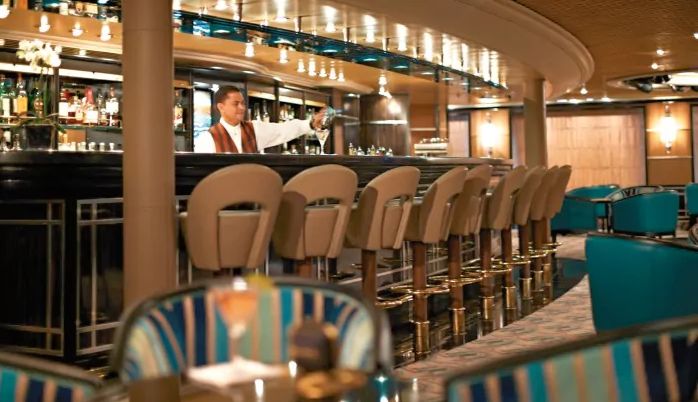
No cruise is complete without meeting new people. Enjoy complimentary drinks and live music at the bar while meeting other guests.
With complimentary cocktails and engaging conversation, live music and a dance floor, Dolce Vita on board Silver Cloud welcomes guests to mix and mingle. When living such unique experiences as these, there is never a dull moment!
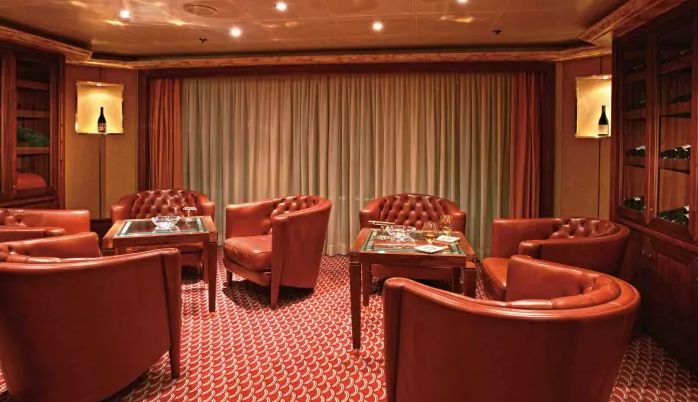
If you appreciate good cognac or premium cigars, be sure to visit the Connoisseur’s Corner to see the ship’s exceptional selection.
The Connoisseur’s Corner offers exceptional cognacs along with a premium selection of cigars for purchase.
The images shown are for illustration purposes only and may not be an exact representation of what you find on the ship.
The images shown are for illustration purposes only and may not be an exact representation of what you find on the ship.
| Return flights including luggage allowance | |||
| Overseas Transfers | |||
| 23 nights aboard the Silver Cloud | |||
| Butler Service in Every Suite | |||
| Gratuities Always Included | |||
| Beverages In-Suite and Throughout the Ship | |||
| Gourmet Dining | |||
| In Suite Dining & 24-Hour Room Service | |||
| Intimate small size ships | |||
| Free Wifi Throughout the Ship | |||
| Free Zodiac, Land and Sea Tours & Activities & Complimentary Expedition gear | |||
| Port Taxes and Fees | |||
 | ABTA and ATOL Protection* | ||
Fly/cruise package |
Date 31st Mar 2025 |
Nts 23 |
Suite £7,400pp |
Suite £7,400pp |
Suite £7,400pp |
Suite £7,400pp |
Suite £7,400pp |
Suite £7,400pp |
Suite £7,400pp |
Suite £7,400pp |
Suite £7,400pp |
Suite £7,400pp |
Suite £7,400pp |
Suite £7,400pp |
Date 31st Mar 2025 |
Nts 23 |
Suite £7,400pp |
Suite £7,400pp |
Suite £7,400pp |
Suite £7,400pp |
Suite £7,400pp |
Suite £7,400pp |
Suite £7,400pp |
Suite £7,400pp |
Suite £7,400pp |
Suite £7,400pp |
Suite £7,400pp |
Suite £7,400pp |
| Suite staterooms from | £7,400pp | ||
| DV | Midship Veranda Suite | £13,900pp | |
| G1 | Grand Suite (1 Bedroom) | £37,900pp | |
| G2 | Grand Suite (2 Bedrooms) |  | |
| ME | Medallion Suite | £29,600pp | |
| O1 | Owner's Suite (1 Bedroom) | £41,800pp | |
| O2 | Owner's Suite (2 Bedrooms) |  | |
| R1 | Royal Suite (1 Bedroom) | £34,300pp | |
| R2 | Royal Suite (2 Bedrooms) |  | |
| SL | Silver Suite | £31,100pp | |
| VI | Vista Suite | £7,400pp | |
| VR | Veranda Suite | £10,600pp | |
| Suite staterooms from | £7,400pp | ||
| DV | Midship Veranda Suite | £13,900pp | |
| G1 | Grand Suite (1 Bedroom) | £37,900pp | |
| G2 | Grand Suite (2 Bedrooms) |  | |
| ME | Medallion Suite | £29,600pp | |
| O1 | Owner's Suite (1 Bedroom) | £41,800pp | |
| O2 | Owner's Suite (2 Bedrooms) |  | |
| R1 | Royal Suite (1 Bedroom) | £34,300pp | |
| R2 | Royal Suite (2 Bedrooms) |  | |
| SL | Silver Suite | £31,100pp | |
| VI | Vista Suite | £7,400pp | |
| VR | Veranda Suite | £10,600pp | |
| Suite staterooms from | £7,400pp | ||
| DV | Midship Veranda Suite | £13,900pp | |
| G1 | Grand Suite (1 Bedroom) | £37,900pp | |
| G2 | Grand Suite (2 Bedrooms) |  | |
| ME | Medallion Suite | £29,600pp | |
| O1 | Owner's Suite (1 Bedroom) | £41,800pp | |
| O2 | Owner's Suite (2 Bedrooms) |  | |
| R1 | Royal Suite (1 Bedroom) | £34,300pp | |
| R2 | Royal Suite (2 Bedrooms) |  | |
| SL | Silver Suite | £31,100pp | |
| VI | Vista Suite | £7,400pp | |
| VR | Veranda Suite | £10,600pp | |
| Suite staterooms from | £7,400pp | ||
| DV | Midship Veranda Suite | £13,900pp | |
| G1 | Grand Suite (1 Bedroom) | £37,900pp | |
| G2 | Grand Suite (2 Bedrooms) |  | |
| ME | Medallion Suite | £29,600pp | |
| O1 | Owner's Suite (1 Bedroom) | £41,800pp | |
| O2 | Owner's Suite (2 Bedrooms) |  | |
| R1 | Royal Suite (1 Bedroom) | £34,300pp | |
| R2 | Royal Suite (2 Bedrooms) |  | |
| SL | Silver Suite | £31,100pp | |
| VI | Vista Suite | £7,400pp | |
| VR | Veranda Suite | £10,600pp | |
| Suite staterooms from | £7,400pp | ||
| DV | Midship Veranda Suite | £13,900pp | |
| G1 | Grand Suite (1 Bedroom) | £37,900pp | |
| G2 | Grand Suite (2 Bedrooms) |  | |
| ME | Medallion Suite | £29,600pp | |
| O1 | Owner's Suite (1 Bedroom) | £41,800pp | |
| O2 | Owner's Suite (2 Bedrooms) |  | |
| R1 | Royal Suite (1 Bedroom) | £34,300pp | |
| R2 | Royal Suite (2 Bedrooms) |  | |
| SL | Silver Suite | £31,100pp | |
| VI | Vista Suite | £7,400pp | |
| VR | Veranda Suite | £10,600pp | |
| Suite staterooms from | £7,400pp | ||
| DV | Midship Veranda Suite | £13,900pp | |
| G1 | Grand Suite (1 Bedroom) | £37,900pp | |
| G2 | Grand Suite (2 Bedrooms) |  | |
| ME | Medallion Suite | £29,600pp | |
| O1 | Owner's Suite (1 Bedroom) | £41,800pp | |
| O2 | Owner's Suite (2 Bedrooms) |  | |
| R1 | Royal Suite (1 Bedroom) | £34,300pp | |
| R2 | Royal Suite (2 Bedrooms) |  | |
| SL | Silver Suite | £31,100pp | |
| VI | Vista Suite | £7,400pp | |
| VR | Veranda Suite | £10,600pp | |
| Suite staterooms from | £7,400pp | ||
| DV | Midship Veranda Suite | £13,900pp | |
| G1 | Grand Suite (1 Bedroom) | £37,900pp | |
| G2 | Grand Suite (2 Bedrooms) |  | |
| ME | Medallion Suite | £29,600pp | |
| O1 | Owner's Suite (1 Bedroom) | £41,800pp | |
| O2 | Owner's Suite (2 Bedrooms) |  | |
| R1 | Royal Suite (1 Bedroom) | £34,300pp | |
| R2 | Royal Suite (2 Bedrooms) |  | |
| SL | Silver Suite | £31,100pp | |
| VI | Vista Suite | £7,400pp | |
| VR | Veranda Suite | £10,600pp | |
| Suite staterooms from | £7,400pp | ||
| DV | Midship Veranda Suite | £13,900pp | |
| G1 | Grand Suite (1 Bedroom) | £37,900pp | |
| G2 | Grand Suite (2 Bedrooms) |  | |
| ME | Medallion Suite | £29,600pp | |
| O1 | Owner's Suite (1 Bedroom) | £41,800pp | |
| O2 | Owner's Suite (2 Bedrooms) |  | |
| R1 | Royal Suite (1 Bedroom) | £34,300pp | |
| R2 | Royal Suite (2 Bedrooms) |  | |
| SL | Silver Suite | £31,100pp | |
| VI | Vista Suite | £7,400pp | |
| VR | Veranda Suite | £10,600pp | |
| Suite staterooms from | £7,400pp | ||
| DV | Midship Veranda Suite | £13,900pp | |
| G1 | Grand Suite (1 Bedroom) | £37,900pp | |
| G2 | Grand Suite (2 Bedrooms) |  | |
| ME | Medallion Suite | £29,600pp | |
| O1 | Owner's Suite (1 Bedroom) | £41,800pp | |
| O2 | Owner's Suite (2 Bedrooms) |  | |
| R1 | Royal Suite (1 Bedroom) | £34,300pp | |
| R2 | Royal Suite (2 Bedrooms) |  | |
| SL | Silver Suite | £31,100pp | |
| VI | Vista Suite | £7,400pp | |
| VR | Veranda Suite | £10,600pp | |
| Suite staterooms from | £7,400pp | ||
| DV | Midship Veranda Suite | £13,900pp | |
| G1 | Grand Suite (1 Bedroom) | £37,900pp | |
| G2 | Grand Suite (2 Bedrooms) |  | |
| ME | Medallion Suite | £29,600pp | |
| O1 | Owner's Suite (1 Bedroom) | £41,800pp | |
| O2 | Owner's Suite (2 Bedrooms) |  | |
| R1 | Royal Suite (1 Bedroom) | £34,300pp | |
| R2 | Royal Suite (2 Bedrooms) |  | |
| SL | Silver Suite | £31,100pp | |
| VI | Vista Suite | £7,400pp | |
| VR | Veranda Suite | £10,600pp | |
| Suite staterooms from | £7,400pp | ||
| DV | Midship Veranda Suite | £13,900pp | |
| G1 | Grand Suite (1 Bedroom) | £37,900pp | |
| G2 | Grand Suite (2 Bedrooms) |  | |
| ME | Medallion Suite | £29,600pp | |
| O1 | Owner's Suite (1 Bedroom) | £41,800pp | |
| O2 | Owner's Suite (2 Bedrooms) |  | |
| R1 | Royal Suite (1 Bedroom) | £34,300pp | |
| R2 | Royal Suite (2 Bedrooms) |  | |
| SL | Silver Suite | £31,100pp | |
| VI | Vista Suite | £7,400pp | |
| VR | Veranda Suite | £10,600pp | |
| Suite staterooms from | £7,400pp | ||
| DV | Midship Veranda Suite | £13,900pp | |
| G1 | Grand Suite (1 Bedroom) | £37,900pp | |
| G2 | Grand Suite (2 Bedrooms) |  | |
| ME | Medallion Suite | £29,600pp | |
| O1 | Owner's Suite (1 Bedroom) | £41,800pp | |
| O2 | Owner's Suite (2 Bedrooms) |  | |
| R1 | Royal Suite (1 Bedroom) | £34,300pp | |
| R2 | Royal Suite (2 Bedrooms) |  | |
| SL | Silver Suite | £31,100pp | |
| VI | Vista Suite | £7,400pp | |
| VR | Veranda Suite | £10,600pp | |
Fusion Cruises when selling travel arrangements is a trading name of The Midcounties Co-operative Ltd. Fusion Cruises is an Accredited Body Member of Midcounties Co-operative Travel Consortium. (ABTA:P6652, ATOL:6053).
Book with Confidence. We are a Member of ABTA which means you have the benefit of ABTA’s assistance and Code of Conduct.
Some of the flights and flight-inclusive holidays on this website are financially protected by the ATOL scheme but ATOL protection does not apply to all holiday and travel services offered on this website. This website will provide you with information on the protection that applies in the case of each holiday and travel service offered before you make your booking. If you do not receive an ATOL Certificate then the booking will not be ATOL protected. If you do receive an ATOL Certificate but all parts of your trip are not listed on it, those parts will not be ATOL protected. Please see our booking conditions for information, or for more information about financial protection and the ATOL Certificate go to: www.caa.co.uk
